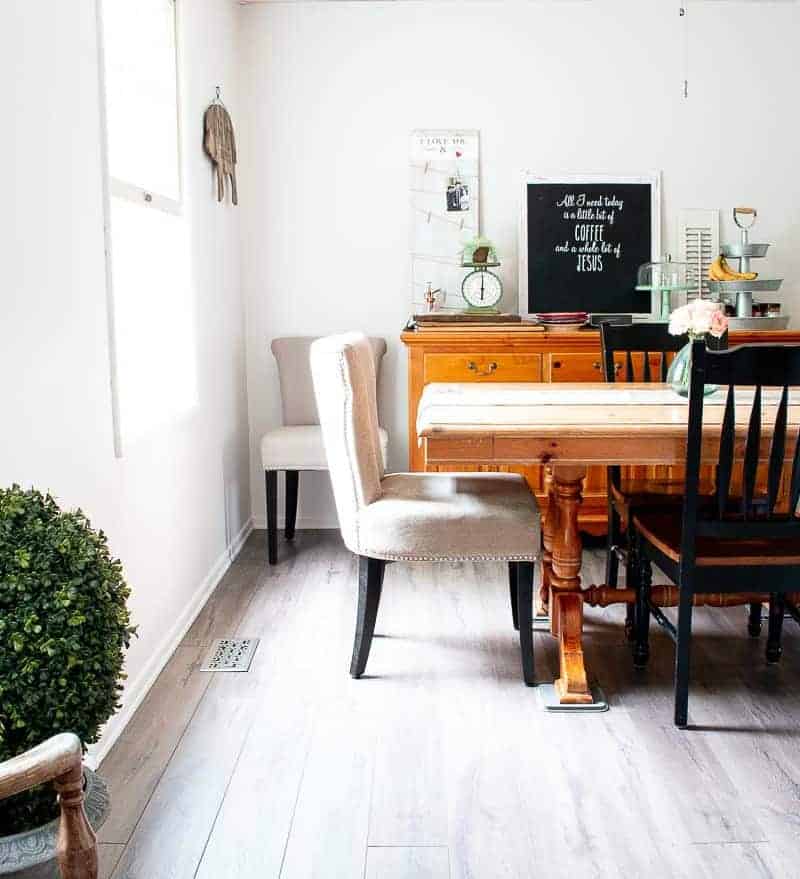Budget-Friendly Living Room Décor Hacks
Your living room is the heart of your home, a place where you relax, entertain guests, and create lasting memories. Whether you're starting fresh or looking to update your current space, the right décor can transform your living room into a cozy, stylish sanctuary.

Finding your personal style while balancing comfort and functionality is the key to creating a living room you'll love spending time in.
*This post may contain affiliate links and I’ll earn a commission if you shop through them. You can read my full disclosure here.
Looking for inspiration? Today's trends offer something for everyone. You can embrace Nate Berkus' tips for a casual yet classy vibe or explore coastal colors for a refreshing feel.
From neutral and black color schemes to entertainment centers that blend aesthetics with function, there are countless ways to express your personality through your living room design.
Even small changes can make a big difference in your space. New throw pillows, a statement piece of art, or rearranging your furniture might be all you need to breathe new life into your living room.
Remember that your living room should reflect who you are and what makes you comfortable—after all, you're the one who'll be enjoying it every day!
Selecting a Color Palette
Start with colors that make you feel good. Paint is the fastest way to change your room's mood. For a calm space, try soft blues or greens. Want something energetic? Go for yellows or bright accent colors.
I suggest picking a main color and adding 2-3 complementary shades. This creates depth without overwhelming the eye.
Consider your existing furniture before choosing paint. That burgundy sofa might clash with orange walls!
Test paint samples on your wall and see them in different lighting before committing.
Remember that neutrals (whites, grays, beiges) are always safe choices that let your furniture and accessories shine. They also make your room feel bigger and brighter.
Using Textures

Textures add dimension to your living room that color alone can't achieve. Mix smooth with rough, shiny with matte for visual interest.
Throw pillows are texture gold mines! Try combining velvet, knit, and woven pillows on your sofa. Add a chunky throw blanket draped over an armrest for instant coziness.
Area rugs anchor your space while adding softness underfoot. Choose one that complements your color scheme but has enough texture to hide everyday dirt.
Don't forget your walls! Textured wallpaper, woven wall hangings, or canvas art can break up flat surfaces.
Even bookshelves with varied objects create textural interest that draws the eye.
Utilizing Space with Furniture
Your furniture arrangement sets the tone for how people use your living room.
Start with your focal point—typically a fireplace or TV stand—and arrange seating to face it.
For small rooms, choose multi-purpose pieces like an ottoman that serves as coffee table, extra seating, and storage. Pull furniture away from walls to create conversation areas that feel intimate rather than sparse.
Accent chairs add personality while providing flexible seating. Place them at angles to soften the room's lines and create flow between different areas.
Mind your traffic patterns! Leave clear paths for walking through the room without obstacles. A well-arranged living room invites you to relax without feeling cramped or cluttered.
Consider scale too. Oversized furniture in a small room feels crowded, while tiny pieces in a large space look lost. Measure your room before shopping!
Coffee Table Choices

Your coffee table does more than just hold your drinks. It serves as a focal point and workhorse in your living room.
Consider a table with storage drawers or shelves to keep remotes, magazines, and other items neatly tucked away.
For small spaces, try nesting tables that can be spread out when you have guests and tucked together when you need floor space. Glass-topped tables create a sense of openness, while wood brings warmth.
Multi-functional options like ottomans with removable tops offer both seating and storage. You can also opt for a trunk-style coffee table to store extra blankets or games while adding character to your room.
Match your table height to your sofa—typically, the table should be the same height as or slightly lower than your sofa cushions for easy reach.
Comfort with Pillows and Throws

Transform your sofa from just furniture to a cozy retreat with the right pillows and throws.
Mix pillow sizes for visual interest—try pairing 22-inch square pillows with smaller 18-inch ones and perhaps a lumbar pillow for back support.
Throw pillows in different textures (velvet, linen, knit) add dimension even when using a similar color palette. You don't need to match perfectly—complementary colors create a more interesting look.
For throw blankets, consider both function and beauty. A chunky knit throw adds texture while providing warmth on chilly evenings.
Drape throws casually over sofa arms or neatly fold them on ottomans for easy access.
Rotate your pillows and throws seasonally—lighter fabrics for summer and heavier, warmer options for winter—to refresh your space without major changes.
Area Rugs to Define Spaces
An area rug does more than protect your floors—it defines and unifies your seating area. The right size is crucial: your rug should be large enough that at least the front legs of all furniture pieces sit on it.
For open floor plans, use rugs to visually separate your living room from dining or work areas. Consider traffic patterns when placing your rug, ensuring it extends beyond natural walkways.
Material matters based on your lifestyle. If you have kids or
For luxurious comfort, consider plush high-pile rugs in low-traffic areas.
Layer rugs for added texture and interest—try a smaller statement rug over a larger neutral one. This technique adds warmth while protecting high-traffic spots from wear.
Choosing the Right Wall Art

Wall art is the quickest way to transform your living room's look and feel. Choose pieces that speak to you personally rather than following trends blindly.
For a cohesive look, select artwork that complements your color scheme. Large statement pieces work well above sofas, while gallery walls add interest to empty walls.
Consider these options:
- Canvas prints for a modern feel
- Framed photos for personal connection
- Vintage posters for retro charm
- Metal or wooden wall sculptures for dimension
Don't hang your art too high! The center should be at eye level, about 57-60 inches from the floor.
For gallery walls, treat the entire arrangement as one piece when determining height.
Reflecting Style with Mirrors
Mirrors aren't just practical—they're powerful design tools. A well-placed mirror can make your living room appear larger and brighter by reflecting light.
A full-length mirror leaning against the wall adds casual elegance while serving a practical purpose.
Round mirrors soften rooms with many angular features, while ornate frames can become artistic focal points.
Try these mirror placements:
- Across from windows to maximize natural light
- Behind table lamps to amplify light in evening hours
- In narrow hallways or small living rooms to create depth
- As part of a gallery wall for unexpected dimension
Mirrors with unique frames can serve as art pieces themselves. Choose metal finishes that match your existing hardware for a coordinated look.
Showcasing Pottery and Accents

Pottery and decorative accents add personality and texture to your living room.
Ceramic vases, bowls, and sculptures bring organic shapes and artistic touches to shelves and tables.
Mix heights, textures, and materials for visual interest. Group items in odd numbers (threes and fives work best) for a more natural arrangement.
Empty spaces are important too—don't overcrowd surfaces.
Rotate your decorative items seasonally to keep your space feeling fresh. Display pieces that have meaning:
- Family heirlooms that tell a story
- Handcrafted pottery from local artists
- Items collected during travels
- Seasonal elements like pine cones in winter or seashells in summer
Plants paired with beautiful pottery create living focal points.
Try succulents in small ceramic pots for low-maintenance greenery that complements your aesthetic touches.
Keeping Favorites Organized
A favorites list is your digital mood board for living room ideas. Most home décor sites let you save items you love for later consideration.
You can organize your favorites by creating different collections. Try grouping items by color scheme, room section, or project timeline.
This makes it easier to plan your space transformation step by step.
Sharing your favorites list with friends or family can help when you're stuck between choices.
They can view your selections and offer opinions without having to shop together physically.
The best part? Your favorites list travels with you. Whether you're browsing on your phone in a store or relaxing with your laptop at home, your saved items are always accessible with a quick sign in.
Guest Author - Julia from Jully's Place
Julia is a home décor enthusiast and DIY lover passionate about transforming spaces on a budget. After renovating her first apartment from scratch, she now shares creative decorating tips and budget-friendly home improvement ideas on her blog, Jully's Place.






